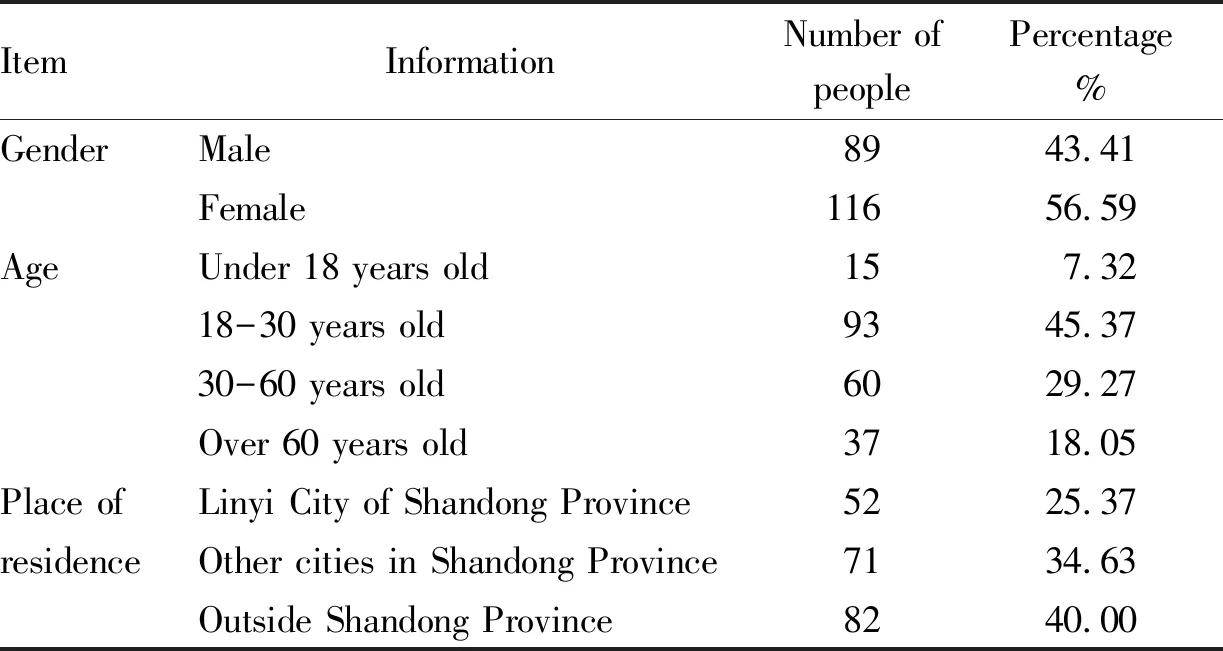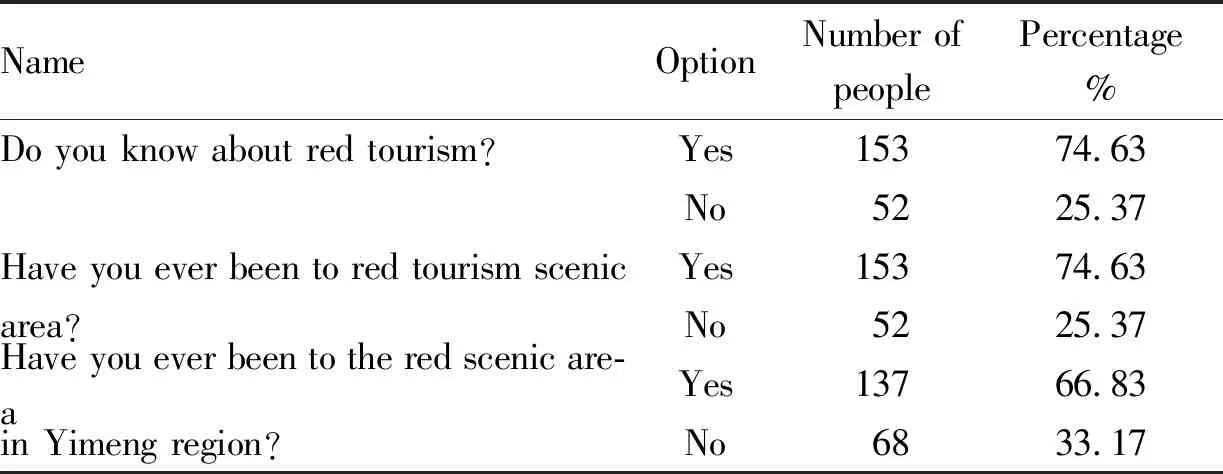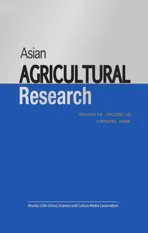Development of Yimeng Red Tourism Resources from the Perspective of Tourist Perception
2023-10-28XiaomeiLIUHuiWANGXiaoPENGYanLI
Xiaomei LIU, Hui WANG, Xiao PENG, Yan LI
1. School of Tourism, Taishan University, Tai’an 271021, China; 2. School of Physical Education, Taishan University, Tai’an 271021, China
Abstract In this paper, the connotation of red tourism is explained from a new perspective firstly. On the basis of summarizing and evaluating the red tourism resources in Yimeng, combined with the current development status of red tourism in Yimeng region, based on the subjective evaluation of tourists on the development of red tourism in Yimeng region, several targeted suggestions for the development of red tourism in Yimeng are proposed.
Key words Red tourism resources, Yimeng region, Tourist evaluation, Development
1 Introduction
With the support of national policies and the improvement of economic and social development levels in recent years, the people have been pursuing more spiritual enjoyment under the conditions of satisfying their material lives. On the occasion of the 100thanniversary of the founding of the CPC, the red tourism activity of "taking the party as the core and the people as the center" has been deeply carried out nationwide, which has brought new opportunities to vigorously develop the red tourism industry. The Yimeng region is a holy land of red culture, with abundant red tourism resources such as revolutionary historical events and revolutionary relics. General secretary Xi Jinping highly praised the Yimeng spirit of "unitybetweenthe people and the CPC, the people’s deepbond withtheir army, and their willingness toshare a common destiny with both the Party and the army". In this paper, the Yimeng region is taken as the research object. Through sorting and evaluating its red tourism resources, constructive and effective strategies are proposed for the development of Yimeng red tourism resources from the perspective of tourists.
2 Overview of domestic and international research
In foreign countries, although there is no concept of "red tourism", there are similar concepts, such as cultural heritage tourism, political education tourism,etc.They are consistent with the "red tourism" advocated in China, and refer to tourism carried out to commemorate revolutionary events or characters and enhance patriotism. Some socialist countries, such as Laos, Vietnam, Cuba,etc., combine resources (anti aggression war sites and revolutionary historical sites) with the tourism industry to form tourism products (war tourism, military tourism, patriotic tourism,etc.)[1], which also share the same basic characteristics as domestic red tourism.
At present, there are not many achievements in the basic theoretical research of red tourism by Chinese scholars overall. TheResearchontheBasicTheoryofRedTourismby Zhou Zhenguoetal.systematically elaborates on the basic concept of red tourism, laying a solid foundation for the theory of red tourism[2]. Liu Sha’sInvestigationontheHistoryofRedTourism[3]provides a detailed review of the development and basic theories of red tourism from different development periods. In terms of the concept of red tourism, scholars such as Li Zongyao and Yin Xiaoying define red tourism as a tourism behavior in which tourists engage in patriotic education during their visits to revolutionary sites and memorials[4-5]. In terms of the development of red tourism resources, Shi Yunli analyzes the current situation of red tourism resources in Linyi City and proposes some countermeasures for its development[6].
3 Evaluation and development status of Yimeng red tourism resources
3.1 Overview and evaluation of Yimeng red tourism resourcesYimeng Old District is located in the southeast of Shandong Province, bordering Jiangsu. It borders Rizhao in the east, Zaozhuang, Jining, and Tai’an in the west, and Zibo and Weifang in the north, with a superior geographical location. There have been many inspiring revolutionary stories happening here. Countless proletarian revolutionaries such as Liu Shaoqi, Chen Yi, and Su Yu have fought and lived here, leaving behind many precious red cultural heritage and revolutionary spirit[7].
There is currently no academic standard for evaluating red tourism resources. Based on the actual situation of red tourism resources in Yimeng region, a qualitative evaluation of the red tourism resources in Yimeng region is conducted. According to the standard from theClassification,InvestigationandEvaluationofTourismResources(GB/T 18972-2003), experts point out that the red tourism resources in Yimeng mainly have the following characteristics: (i) the red tourism resources are mainly revolutionary holy sites, historical cities, red commemorative sites, and revolutionary sites, with high historical and ornamental value. (ii) The Yimeng Mountains are the birthplace and practice of the Yimeng spirit. During the revolutionary war, the masses paid a huge price and sacrifice for the victory of the Chinese revolution, leaving behind a large number of revolutionary cultural relics, ruins, and rich cultural landscapes, which have high social value, ornamental value, and scientific research value. (iii) The core of developing red tourism is the red tourism resources based on revolutionary sites, which are mainly distributed in old areas and mountainous areas, with a large number, complete type, and rich connotation. (iv) The red tourism resources are centered around the "Yimeng Spirit" and have high spiritual value. (v) The composition and combination of red tourism resources are good, mostly located in scenic spots, with good development space and potential. (vi) Red tourism resources are widely distributed, with more points, broad area and uneven distribution, mainly in old and mountainous areas, which can form a significant scale effect.
The Yimeng spirit is the spiritual pillar of the Chinese revolution, and its formation and development are not only influenced by the history of the red revolution, but also witness to the tremendous contributions of the local people. Red tourism resources are the carrier and witness of the Yimeng spirit, reflecting the glorious process of the Chinese revolution and socialist construction. Yimeng’s red tourism resources have distinct characteristics and rich cultural connotations, including both rich material forms and profound intangible cultural heritage. The red tourism resources in Yimeng are diverse in types, widely distributed, and well combined, with high historical, artistic, scientific, educational, and aesthetic values, providing a solid resource foundation for the development of red tourism in the Yimeng region.
3.2 Development statusIn recent years, the development of red tourism resources in the Yimeng region has been rapidly changing, and the tourism product system has become increasingly rich. The Yimeng region has formed a red culture, launched high-quality red culture tourism routes with Yimeng characteristics, further extended and improved the red tourism product system, and meticulously created a batch of tourism products with distinct themes, rich content, and diverse forms. At present, there are 86 Yimeng red tourism scenic spots, including 9 national AAA level scenic spots and 18 AA level scenic spots, forming a group of well-known tourism brands such as Yimeng Red Film and Television Base, Yimeng Mountain Tourist Area, Yimeng Revolution Memorial Hall,etc.In addition, the Yimeng region regards the development of red tourism as an important lever to promote economic transformation and upgrading. It combines the rich red tourism resources and beautiful natural landscapes of the Yimeng region, integrating natural scenery, rural scenery, folk customs and other resources, and forms a comprehensive tourism system supplemented by ecological tourism, rural tourism, leisure vacation,etc.The Yimeng region will also deepen the construction of red cultural tourism projects, accelerate the construction of scenic spots such as the Menglianggu Tourist Area, further enrich the connotation of scenic spots such as the Red Sister-in-law Memorial Hall, and strive to make the Yimeng region become the most influential red cultural tourism destination in China.
4 Questionnaire survey on the development of Yimeng red tourism from the perspective of tourists
4.1 Questionnaire designIn order to better understand the current situation of red tourism development in the Yimeng region, survey questionnaire method is adopted, and major red tourism scenic spots are selected to distribute questionnaires for investigation. The questionnaire is divided into three parts: the first part is basic information about tourists, such as gender, age, and place of residence; the second part is to understand tourists’ understanding of red tourism; the third part investigates tourists’ experience and feelings towards red tourism in the Yimeng region.
4.2 Conclusion of the questionnaire on the development of Yimeng red tourism resourcesThis survey questionnaire was conducted from June 20 to July 20, 2023. A total of 240 questionnaires were distributed and collected, with a response rate rate of 100% and an effective rate of 85% (Table 1).

Table 1 Personal information statistics of tourists
4.2.1Tourists’ perception of red tourism. 74.63% of respondents are aware of red tourism, indicating that nearly a quarter of people in daily life are not aware of red tourism. It can be seen that the publicity and influence of red tourism still need to be improved. 74.63% of respondents have visited red tourist attractions, and nearly a quarter of respondents have not visited red tourist attractions. Only 66.83% of the 205 respondents stated that they have visited and browsed the red tourism scenic area in the Yimeng region.

Table 2 Tourists’ perception of red tourism
4.2.2Respondents’ experience and feelings towards the Yimeng red tourism scenic area. The questionnaire survey collected the overall feelings of the respondents towards the Yimeng red tourism scenic area, infrastructure, and atmosphere of scenic area. The survey results show that nearly 81% of respondents are satisfied with the overall impression of the scenic area, nearly 11.2% of respondents say they have average overall impression of the scenic area, and 7.8% of respondents say they are not satisfied with the overall impression of the scenic area, indicating that the service facilities and quality of the scenic area still need to be improved. In the question of how the infrastructure of scenic spots is, 71.22% of respondents say that the infrastructure of the scenic spots is very complete, while 18.05% of respondents say that the infrastructure of the scenic spots still needs improvement.
4.2.3Experience and gains of the respondents after visiting the scenic area. According to questionnaire statistics, 76.5% of tourists have gained an understanding of local red culture after visiting and browsing red tourism attractions, while 23.5% of tourists say that their impression of red tourism is not deep enough after visiting and browsing. 83.41% of tourists say they will continue to visit the scenic area in the future, while 16.59% of tourists say they will not visit again.
5 Countermeasures for the development of Yimeng red tourism resources
The development of red tourism in Yimeng region is rapid, but many problems have also emerged during the development process. Based on a questionnaire survey, several suggestions are proposed to promote the sustainable development of Yimeng’s red tourism resources.
5.1 Highlighting regional resource characteristicsCurrently, people’s demand for tourism is becoming increasingly diverse, with a greater emphasis on personalized leisure experiences. Based on the geographical advantages and resource characteristics of the Yimeng region, combined with the historical culture and local customs of the Yimeng Revolutionary Old Area, it should focus on leveraging its characteristics and advantages, highlight the spiritual connotation of Yimeng and the regional characteristics of Yimeng, and play the "red" card of Yimeng. For example, different themed tourism products such as Red Journey, Education Journey, Landscape Journey, and Cultural Journey can be designed, and a red cultural tourism system with Yimeng characteristics can be designed. At the same time, by continuously enriching the types of tourism products, it aims to meet the needs of tourists with diversified and differentiated products. Different products are designed for different groups, and tourist satisfaction is enhanced through various forms of activities. For example, activities such as summer and winter camps can be held for the youth group; some fitness and health activities can be organized for middle-aged and elderly groups, as well as cultural exchange activities.
5.2 Emphasizing tourist experience designIt should continuously improve service quality and level, and enhance tourists’ sense of participation and experience. For example, dedicated roads and supporting infrastructure for red tourism could be built in red tourism scenic areas, and red education bases and red theme parks,etc.could be established. In terms of venue construction, it is necessary to closely integrate with the current technological development, introduce 3D and VR to invent reality, so that tourists can immerse themselves. Modern technologies such as sound and optoelectronics could be used to enhance the listening effect and impact on the body. At the same time, the instructors in the scenic area can also be combined with the dynamic display corridor of red culture, making the presentation more vivid. The rich red culture and art in Yimeng area could be introduced, such as the famousYimengMountainDitty, wonderfulMengshanYishuiand other performing arts products. They could be promoted in the form of film and television works in a way that the audience likes, and it should actively create the "Internet+red tourism" model.
5.3 Creating a comprehensive service for scenic spotsIt should strengthen the construction and improvement of facilities in red tourism scenic areas in areas such as food, accommodation, transportation, tourism, shopping, and entertainment. It should further strengthen the road traffic in the red tourism scenic area. On the basis of maintaining the original slate road, it could add or repair the main road for convenient passage of vehicles. It should increase the dedicated transportation routes for red tourism, increase the frequency of tourist buses in scenic areas, and reduce traffic congestion caused by too many cars. It could design "Anti Japanese War" themed hotels, "Yimeng Red Sister-in-law" farmhouses, and build hotels that incorporate "red" cultural elements to increase the experience of tourist attractions. The dining environment of the scenic area could be improved, and themed restaurants could be designed in conjunction with surrounding farmhouses, such as the "Recalling the Past" hall, the "Yimeng Red Sister-in-law" hall, and the "Yimeng Red Song" hall. The waiters wear military uniforms and the tableware is printed with the unique charm of the Yimeng region. Local specialty snack streets could be build around the scenic area to meet the culinary needs of tourists; dishes with rich regional flavors could be produced using vegetables grown by local farmers and raised poultry as raw materials. Emphasis should be placed on training scenic area practition-ers, not only in terms of language skills and tourism etiquette, but also in learning professional knowledge related to red tourism, and building a tourism service team with high professional quality. It should standardize the service quality supervision system within the scenic area, establish a reward and punishment mechanism, and improve the service level of hotel employees.
5.4 Enhancing the effectiveness of media promotion in scenic areasIt should make good use of new media platforms to vigorously promote the red spirit and history of the Yimeng region. On the most popular platforms such as Tiktok and Today’s Headlines, it can effectively mobilize the patriotic feelings of the audience and improve people’s awareness of Yimeng’s red culture by making excellent promotional short films of Yimeng’s red history and stories of red characters. It should grasp the psychology and characteristics of the audience, and condense the grand and heavy red spirit into a short and concise video form, so as to see the big from the small and understand from the small, and generate strong interest in the audience. In addition, excellent articles on the red history and spirit of Yimeng can be regularly launched through online platforms such as Weibo and WeChat, in order to attract more people to travel to Yimeng.
杂志排行
Asian Agricultural Research的其它文章
- Research and Application of Ecological Outdoor Ground Structure with Composite Water Storage and Drainage Function
- Solid Material Formula of Small Fragrant Chicken Soup Stock and Improvement of Boiling Process
- Extraction Conditions of Essential Oil from Eucalyptus Leaves by Distillation
- Bioinformatics Analysis of Q0D1P0 Gene of Mangrove Endophytic Fungus Aspergillus terreus
- Planting Adaptability of Four Kinds of Common Vegetables in Shanghai
- Problems and Countermeasures of Fruit and Vegetable Logistics Distribution Development in Guangxi Zhuang Autonomous Region
